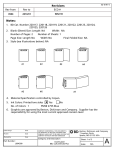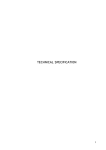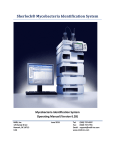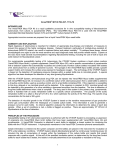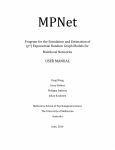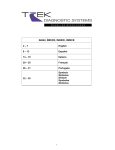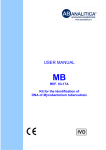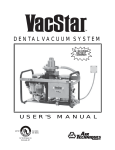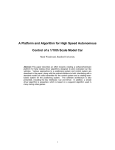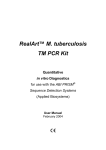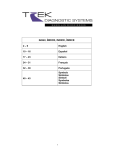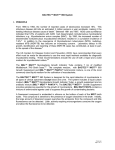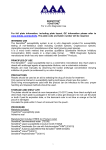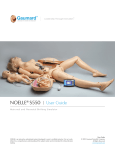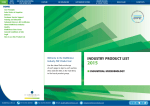Download VersaTREK Myco - Thermo Scientific
Transcript
ENGLISH VersaTREK™ Myco Bottles, 7111-42 VersaTREK Myco GS, 7112-42 VersaTREK Myco AS, 7114-42 VersaTREK Myco PVNA, 7113-42 VersaTREK Connector, 7150-44 INTENDED USE VersaTREK Myco, with VersaTREK Myco GS and either VersaTREK Myco AS or VersaTREK Myco PVNA added, is a selective liquid growth medium for use with the VersaTREK Automated Microbial Detection System (VTI) for the recovery of mycobacteria from sterile body specimens and from digested-decontaminated clinical specimens. SUMMARY AND EXPLANATION The clinical microbiology laboratory may receive a variety of specimens for mycobacterial culture. These may include respiratory specimens, blood and other normally sterile body fluids, urine, stool, tissue, and gastric washes. Conventional culture methods for the isolation of Mycobacterium spp. require the use procedures that include digestion, decontamination, and concentration of specimens; however, results are not available for 2-8 weeks. Several additional weeks are required to identify isolates and complete susceptibility testing procedures. Rapid diagnosis of tuberculosis is important for initiation of appropriate drug therapy and the implementation of measures to prevent the spread of this highly contagious disease. Delayed treatment, in particular of multiple-drug-resistant Mycobacterium tuberculosis (MDR-TB) strains, can result in treatment failure and patient mortality.2 To address these issues, clinical microbiologists are urged to use the most rapid and sensitive diagnostic tests available that provide reliable results. Experts at the Centers for Disease Control and Prevention (CDC) recommend the use of methods that include both a liquid and a solid medium for mycobacterial culture.1 VTI combines a liquid culture medium (VersaTREK Myco), a growth supplement (VersaTREK Myco GS) and, for potentially contaminated specimens, an antibiotic supplement (VersaTREK Myco AS or VersaTREK Myco PVNA) for optimal recovery of mycobacteria, with a detection system that automatically incubates and continuously monitors culture bottles inoculated with specimens suspected of containing mycobacteria. The sponges in the VersaTREK Myco bottles provide a growth support matrix and increase the surface area exposed to headspace oxygen. The technology of VTI is based on the detection of headspace pressure changes within a sealed bottle. VTI monitors changes in either gas production or gas consumption due to microbial growth. A special algorithm has been developed for detection of very slow growing mycobacteria. PRINCIPLES OF THE PROCEDURE Appropriately prepared specimens are inoculated with a syringe and needle into VersaTREK Myco bottles that have been supplemented with VersaTREK Myco GS and, for potentially contaminated specimens, VersaTREK Myco AS or VersaTREK Myco PVNA. VersaTREK Myco PVNA should be used when delays greater than 8 hours are expected before processing. The VersaTREK Connector is attached to each bottle to establish a sterile monitoring pathway with the VTI instrument. A hydrophobic membrane in the VersaTREK Connector prevents aerosolization. Clinical information is entered into the system computer and the bottle is appropriately placed in the instrument for incubation at 35-37°C under stationary conditions. VTI detects mycobacterial growth by automatically monitoring (every 24 minutes) the rate of consumption of oxygen within the headspace of the culture bottle and reports that growth response with a visible signal. REAGENTS VersaTREK Myco Formula* (H2O) Processed Water 11.5 ml (MDK) Middlebrook 7H9 Broth 0.56% w/v (CAS) Casitone 0.12% w/v (GLY) Glycerol 0.24% w/v (SBC) Sodium Bicarbonate 0.026% w/v VersaTREK Myco also contains sponges. VersaTREK Myco GS Formula* (H2O) Processed Water (BSA) Bovine Serum Albumin (DEX) Dextrose (OLA) Oleic Acid (CAT) Catalase (NaCl) Sodium Chloride 50 ml 7.5% w/v 3.0% w/v 0.09% w/v 0.003% w/v 1.27% w/v VersaTREK Myco AS and VersaTREK Myco PVNA contain a lyophilized mixture of antimicrobial agents that are rehydrated to 25 ml. VersaTREK Myco AS Formula* (H2O) Processed Water (PXB) Polymyxin B (AZL) Azlocillin (FOS) Fosfomycin (NA) Nalidixic Acid (AMB) Amphotericin B (STB) Stabilizer (FIL) Filler VersaTREK Myco PVNA Formula* (H2O) Processed Water (PXB) Polymyxin B (NA) Nalidixic Acid (AMB) Amphotericin B (VAN) Vancomycin (SA) Solubilizing Agent 25 ml 0.02% w/v 0.0075% w/v 0.054% w/v 0.042% w/v 0.015% w/v 1% w/v 7.7% w/v 25 ml 0.02% w/v 0.06% w/v 0.015% w/v 0.009% w/v 5% w/v *Adjusted and/or supplemented to meet performance criteria. PRECAUTIONS 1. For In Vitro Diagnostic Use. 2. Refer to VersaTREK Myco AS or VersaTREK Myco PVNA Material Safety Data Sheet for complete hazard information. 3. WARNING! Potential infectious test specimen. Infectious agents may be present in specimens. Reagents contain material of animal origin and so are potential carriers or transmitters of disease. Follow Universal Precautions and institutional policy in handling and disposing of infectious agents. 1 ENGLISH 4. 5. 6. 7. 8. 9. When working with M. tuberculosis grown in culture, the use of Biosafety Level 3 practices, containment equipment, and facilities is recommended.6 The VersaTREK Connector contains a sharp recessed needle that is sterile upon first removing the seal, but is potentially contaminated following use. Follow institutional policy for handling and disposing of blood-contaminated devices. Do not handle in a casual manner. Sterilize prior to disposal. Dispose of in an approved sharps container. Do not reuse. Visually inspect all bottles for contamination, cracks, or other signs of deterioration. Do not use bottles that appear turbid or damaged. Use only needle locking syringes. Autoclave all VersaTREK Myco bottles prior to disposal. If seal is broken, DO NOT USE VersaTREK connector and discard in sharps container. STORAGE VersaTREK Myco: Store at 15-30°C. Protect from light. DO NOT FREEZE. Broth should appear colorless; do not use if turbid. VersaTREK Myco GS: Store at 2-8°C. Protect from light. VersaTREK Myco AS and VersaTREK Myco PVNA: Store at 2-8°C. Upon rehydration, store at 2-8°C and use within 5 days or aliquot, store at -20°C and use within 3 months. Once thawed, do not refreeze. SPECIMEN COLLECTION PRINCIPLES Specimens from the following sources were used during the clinical evaluation of VTI: respiratory (including sputum, lavage, etc.), body fluids (such as CSF, synovial fluid, pleural fluid, etc.), urine, stool, gastric aspirates, tissues, blood, and bone marrow. Collect and process specimens from different body sites as recommended in Public Health Mycobacteriology: A Guide for the Level III Laboratory3 and in the Clinical Microbiology Procedures Handbook4 or following established laboratory procedures. Note: Blood and bone marrow specimens must be processed using one of the following procedures before inoculating VersaTREK Myco bottles: 1. Isolator tubes: Follow the Isolator manufacturer's directions for lysis and concentration. Inoculate VersaTREK Myco with 1 ml of sediment. 2. Whole blood cells: a. Collect 5-10 ml whole blood into a sterile Vacutainer tube containing sodium polyanetholesulfonate (SPS) or heparin. (A minimum specimen of at least 5 ml is preferred.) Invert the tube several times. b. Transfer the total specimen to a conical 50 ml centrifuge tube. c. Add sterile demineralized water to the 40 ml mark on the tube. This will cause lysis of the cells. d. Centrifuge at 3000 x g for 20 minutes. Decant the supernatant. e. Add 1-2 ml of phosphate buffer to the sediment. Use 1 ml of the resulting specimen to inoculate VersaTREK Myco (#7 below). 3. Buffy coat procedure: a. Use only blood collected in tubes containing SPS or heparin. Tubes containing edetic acid (EDTA) are unacceptable because even trace amounts of EDTA inhibit mycobacterial growth. b. Spin the tube at 1000 RPM for 10 minutes. c. Using a pipette, remove the buffy coat and as small an amount of red blood cells as possible. Place in a sterile tube. Use 1 ml of the buffy coat to inoculate VersaTREK Myco (#7 below). PROCEDURE Materials Provided: VersaTREK Myco VersaTREK Myco GS VersaTREK Myco AS or VersaTREK Myco PVNA VersaTREK Connector Materials Required But Not Provided: Alcohol swabs Autoclave Biological safety cabinet Centrifuge CO2 incubator, 37°C Microscope Middlebrook 7H10 or other mycobacterial agar or egg-based medium Mycobactericidal disinfectant (e.g., AmphylTM, OMNITM, etc.) N-acetyl-L-cysteine powder Slide staining materials Sterile 50 ml conical polypropylene centrifuge tubes Sterile demineralized water Sterile 0.067 M phosphate buffer, pH 6.8 Sterile pipettes (optional) Sterile tuberculin syringes with permanently attached needles Vortex mixer Quality Control Organisms: M.tuberculosis ATCC® 25177 M.fortuitum ATCC® 6841 M.intracellulare ATCC® 13950 M.kansasii ATCC® 12478 M.scrofulaceum ATCC® 19981 Inoculation of VersaTREK Myco Culture Bottles 1. Disinfect the VersaTREK Myco AS or VersaTREK Myco PVNA bottle stopper with alcohol. 2. Aseptically reconstitute VersaTREK Myco AS or VersaTREK Myco PVNA by injecting 25 ml sterile demineralized water through the disinfected septum using a needle and syringe. There will be enough reagent for 50 bottles. 3. Label the VersaTREK Myco culture bottle with patient information. 4. Disinfect the bottle stopper with alcohol. 2 ENGLISH 5. 6. 7. 8. 9. 10. 11. 12. 13. 14. 15. 16. 17. 18. Aseptically add 1 ml of VersaTREK Myco GS by injecting through the septum with a needle and syringe. Aseptically add 0.5 ml of VersaTREK Myco AS or VersaTREK Myco PVNA solution by injecting through the septum with a needle and syringe. Add up to 1 ml of concentrated clinical specimen with a needle and syringe. Note: Significant overfilling of the bottle may cause false-positive results and, in the case of blood specimens from Isolator tubes, may cause inhibition of growth. Inoculate 0.1 ml of the specimen on a Middlebrook 7H10 agar plate or other mycobacterial solid agar or egg-based medium.1 Note: Alternatively, steps 2-7 may be performed by opening the bottles and adding the reagents and sample using sterile pipettes. Care must be taken to maintain aseptic technique. The stopper and cap must be reseated properly to guarantee a sealed system. If the stopper and cap are not seated properly, a leaking bottle error will occur. Wipe the culture bottle and stopper with mycobactericidal disinfectant. Mix by inverting several times. Remove the seal from the bottom of a VersaTREK Connector. Place the needle end of the connector over the culture bottle neck and press vertically down to puncture the culture bottle stopper. Note: Do not invert the culture bottle while the VersaTREK Connector is on the bottle. Fluid in the needle may interfere with the pressure readings for the bottle. Record the patient information in the VTI computer. Place the culture bottle with VersaTREK Connector into the instrument. When the instrument indicates via a steady red light that a particular bottle location contains a positive culture, remove the bottle according to the procedures specified in the VTI User Manual. Allow the bottle to vent through the VersaTREK Connector. In a biological safety cabinet, remove the VersaTREK Connector from the bottle and dispose of it in an approved sharps infectious waste container. Vortex the specimen thoroughly to dislodge organisms from the sponge. After the bottle stopper has been disinfected, obtain specimens for acid-fast staining and subculture using a syringe and needle. If acid-fast organisms are found on the smear, proceed with organism identification. If no organisms are seen on the smear, attach a new VersaTREK Connector, return the bottle to the VTI Instrument and continue incubation. If non-acid-fast organisms are seen on the smear, the bottle contents may be reprocessed through another decontamination procedure and inoculated into a fresh VersaTREK Myco bottle, or discarded and another specimen requested. Organism identification may be determined using nucleic acid probes (AccuProbe). Remove 1.0 ml from a well mixed VersaTREK bottle and centrifuge at 3500 x g for 15 minutes to concentrate the growth. (If the isolate is from a blood culture, the pellet should be resuspended in 0.67M phosphate buffer pH 6.8, vortexed and recentrifuged. This should be repeated until the supernatant is clear.) Resuspend pellets in 7H9 broth equivalent to a No. 1 McFarland standard and assay using the AccuProbe (GenProbe, San Diego, CA) kit following the manufacturer's instructions for broth culture method. It is recommended that if the RLU value falls within the equivocal range (10,000-29,000 RLUs) the specimen should be retested. At the end of the incubation period (6 weeks or as defined by your laboratory procedure manual), a bottle not exhibiting a positive growth response should be visually inspected for turbidity. If the bottle is turbid, obtain a sample for acid-fast staining and subculture as described above. If evidence of turbidity is lacking, the bottle may be discarded. Sterilize bottle contents prior to disposal. RESULTS The detection of microbial growth in the VTI is based on the sensitive measurement of gas production and/or gas consumption within the headspace of a sealed culture bottle. This information is used to generate a curve for each bottle. An internal algorithm analyzes the information to determine the status of each specimen. When a certain set of conditions is met, a bottle is flagged as positive. There are approximately 106 CFU/ml of mycobacteria at the time of detection. TABLE 1. Reporting results Bottle and Smear Status Report Signal+ AFB positive; Acid-Fast Bacilli + (AFB+) identification pending Signal+ No report; or specimen contaminated with non-mycobacterial organisms; AFB unable to determine presence/absence of AFB QUALITY CONTROL A Certificate of Analysis is included with each lot of VersaTREK Myco. Each lot conforms to TREK's quality assurance criteria. If desired, the procedure below can be followed for additional testing. 1. Add 1 ml VersaTREK Myco GS and 0.5 ml rehydrated VersaTREK Myco AS or VersaTREK Myco PVNA to a VersaTREK Myco culture bottle. 2. QC organisms may be used from frozen aliquots or solid medium. Prepare a suspension in sterile 0.85% saline equivalent to a McFarland standard No.1 (approximately 107 CFU/ml). Allow clumps of organism to settle for 30 minutes. Dilute the organism to 104 CFU/ml in sterile saline. Inoculate the bottle with 1 ml of diluted organism. TABLE 2. Expected QC Results Organism ATCC® M. tuberculosis 25177 M. fortuitium 6841 M. intracellulare 13950 M. kansasii 12478 M. scrofulaceum 19981 CFU/ ml 104 104 104 104 104 Days to Positive <14 <14 <14 <14 <14 LIMITATIONS 1. Recovery of mycobacteria in the VersaTREK Myco bottle is dependent on the quality of specimen collected, the numbers of culturable organisms in the specimen volume, and the method of processing. Adherence to procedural instructions is critical for optimum recovery of mycobacteria. Contamination with saprophytic mycobacteria in tap water or other laboratory reagents and equipment may cause positive results (recovery of environmental bacteria not in the clinical specimen). 3 ENGLISH 2. 3. 4. 5. 6. 7. Decontamination by the N-Acetyl-L-Cysteine-Sodium Hydroxide (NALC-NaOH) or Oxalic Acid method is recommended. Other decontamination methods have not been validated for use with VersaTREK Myco culture medium. Digestion/decontamination reagents may have harmful effects on mycobacteria. Mycobacteria may vary in acid-fastness depending on strain, age of culture, and other variables. All bottles with a positive VTI signal or appearing turbid should be subcultured to both selective and non-selective mycobacterial media. Non-mycobacterial species may overgrow mycobacteria present. Such culture bottles should be reprocessed through another decontamination procedure and inoculated into a fresh bottle, or discarded and another specimen requested. VersaTREK Myco bottles with a positive signal may contain one or more species of mycobacteria and/or other non-mycobacterial species. Identification of mycobacteria present requires subculture and additional procedures to identify organisms present. The consistency of microscopic morphology in VersaTREK Myco bottles has not been established. VersaTREK Myco bottles are incubated at 35-37°C, potentially precluding the recovery of mycobacteria requiring other incubation temperatures (e.g., M. marinum, M. ulcerans, M. haemophilum). Recovery of such organisms requires additional culture methods. Organisms with special growth requirements (e.g., M. haemophilum) may not be recovered in VersaTREK Myco when incubated at the appropriate temperature. The following isolates have been recovered either in clinical studies or analytical studies: M. tuberculosis, M. avium-intracellulare, M. kansasii, M. fortuitum, M. bovis, M. chelonae, M. gordonae, M. scrofulaceum, M. xenopi, M. szulgai, M. phlei, M. smegmatis, M. simiae, M. marinum, and M. malmoense. Inversion of the VersaTREK Myco bottles after attachment of the VersaTREK Connector may interfere with the pressure readings for the bottle and is not recommended. Results from the AccuProbe should be interpreted in conjunction with other laboratory and clinical data available to the clinician. A positive AccuProbe result does not rule out a mixed mycobacteria culture. PERFORMANCE CHARACTERISTICS VTI permits recovery of mycobacteria from clinical specimens. Isolation of mycobacteria in the VTI from 3001 specimens was compared to the BACTEC 460 radiometric broth system in a multi-center study. A subset of the total (2805 specimens) was also compared to conventional culture on egg and agar-based media. The laboratories participating in the study were geographically distributed throughout the United States and included large and small teaching and private hospitals with varying patient populations (including AIDS and Cystic Fibrosis patients). A total of 363 specimens were positive in the VTI/BACTEC 460 comparison representing a positivity rate of 12%. Of these positive cultures, 306 (84%) were recovered in the VTI Instrument and 268 (74%) were recovered in the BACTEC system. In the comparison, all of conventional solid media combined detected 92% of the specimens that grew mycobacteria. The VTI instrument demonstrated a rate of 1.1% false-positive (signal positive, no organisms seen) and a 0.6% false-negative rate (signal negative, subculture AFB positive). The false-negative rate is based upon staining and/or subculturing all specimens positive by any method plus 10% of the specimens negative by all three methods. The initial contamination rate was 8.8% and the final was 4.2%. Positive specimens were distributed among the following specimen sources: respiratory (72%), blood (15%), stool (5%), tissue (3.6%), sterile fluids (2.2%), urine (1.4%), and wound (0.8%). The use of nucleic acid probes for identification of mycobacteria directly from a positive VersaTREK Myco bottle has been shown to be accurate and reliable.5 Positive VersaTREK Myco bottles (n=360) were tested with two AccuProbe probes on the day of positivity as described under Procedure. The probes used were determined by pellet pigmentation. A buff colored pellet was tested with probes specific for M. tuberculosis complex and M. avium complex (MAC), while a chromogenic pellet was tested with probes specific for MAC and M. gordonae. Bottles yielding equivocal probe results were incubated at 35°C for 1–3 days before a repeat probe was performed. Results of the study are shown in Table 4. Seven isolates were negative for all probes used and were ultimately identified as other mycobacterial species. TABLE 3. Summary of Clinical Results, Microorganisms Recovered By: Total Total VTI Mycobacterium spp. Isolatesa VersaTREK/ESPb Bactec, and solid M. tuberculosis 68 62 52 M. avium-intracellulare 170 159 89 M. kansasii 7 7 5 M. fortuitum 5 3 0 M. bovis 1 1 1 M. chelonae 9 8 4 M. gordonae 30 20 3 M. scrofulaceum 1 0 0 M. xenopi 6 6 2 M. szulgai 3 3 3 M. species (other) 8 7 1 TOTAL 308 276 160 VersaTREK/ESP only 1 36c,d 0 2 0 0 10d 0 0 0 2 51c,d Bactec only 1 2 0 0 0 0 0 0 2 0 1 6 Solid only 4 3 1 1 0 0 4 1 0 0 1 15 a The number of organisms recovered by any method from specimens tested by all three methods. The total number of organisms recovered in the VTI. p <0.05 for comparison between VTI and BACTEC using the McNemar modification of the chi-square test. d p <0.05 for comparison between VTI and solid media using the McNemar modification of the chi-square test. b c TABLE 4. Direct Testing of Positive VTI Myco Bottles with AccuProbesa Organism M. avium complex Blood specimens Other specimens M. tuberculosis complex Blood specimens Other specimens M. gordonae TOTAL Total Initial Probe Positive Initial Probe Equivocal Initial Probe Negative Probe Positive After Retestb 51 226 43 (84.3%) 199 (88.1%) 8 (15.7%) 24 (10.6%) 0 3 (1.3%) 51 (100%) 226 (100%) 1 37 38 353 1 (100%) 29 (78.4%) 37 (97.4%) 310 0 6 (16.2%) 1 (2.6%) 38 0 2 (5.4%) 0 5 1 (100%) 37 (100%) 38 (100%) 353 a GenProbe, San Diego, CA Multiple retests were required for a final identification of some isolates. For MAC specimens from blood, 1.96%. For MAC specimens from sources other than blood, 1.33%. For M. tuberculosis specimens from sources other than blood, 5.4%. b 4 ENGLISH HAZARD INFORMATION VersaTREK Myco PVNA Xn R42/43 S26 S36 Harmful May cause sensitization by inhalation and skin contact. In case of contact with eyes, rinse immediately with plenty of water and seek medical advice. Wear suitable protective clothing. VersaTREK Myco AS Xn R42/43 R48/23/24/25 R45 S7 S22 S24/25 S26 S36 S45 Harmful May cause sensitization by inhalation and skin contact. Toxic: danger of serious damage to health by prolonged exposure through inhalation, contact with skin, and if swallowed. May cause cancer. Keep container tightly closed. Do not breathe dust. Avoid contact with skin and eyes. In case of contact with eyes, rinse immediately with plenty of water and seek medical advice. Wear suitable protective clothing. In case of accident or if you feel unwell, seek medical advice immediately (show the label where possible). BIBLIOGRAPHY 1. 2. 3. 4. 5. 6. Tenover, F.C., J.T. Crawford, R.E. Huebner, L.J. Geiter, C.R Horsburgh, Jr., and R.C. Good. 1993. J. Clin. Microbiol. 31:767-770. Stratton, C.W. 1992. Inf. Dis. Newsl. 11:73-80. Kent, P.T. and G.P. Kubica. 1985. Public Health Mycobacteriology: A Guide for the Level III Laboratory. U.S. Dept. H.H.S., Centers for Disease Control, Atlanta, GA. Garcia, L.S. 2010. Clinical Microbiology Procedures Handbook. 3rd ed. ASM Press, Washington, D.C LaBombardi, V.J., L. Carter, and S. Massarella. 1997. J. Clin. Microbiol. 35:1002-1004. Chosewood, L.C. and D.E. Wilson. 2007. Biosafety in Microbiological and Biomedical Laboratories. 5th ed. Centers for Disease Control and Prevention and National Institutes of Health, Washington, D.C. Symbol Legend REF Catalogue number IVD In Vitro Diagnostic Medical Device Manufacturer Temperature limitation (storage temp.) Use by (expiration date) LOT Lot number Consult instructions for use EC REP Authorized European Representative Contains sufficient for <n> tests Keep away from heat Remel Inc. 12076 Santa Fe Drive, Lenexa, KS 66215, USA www.remel.com 1-800-255-6730 EC REP TREK Diagnostic Systems Units 17 – 19, Birches Industrial Estate East Grinstead West Sussex, RH19 1XZ, UK www.trekds.com, +44 1342 318777 ATCC is a trademark of the American Type Culture Collection. VersaTREK is a trademark of Thermo Fisher Scientific and its subsidiaries. For technical information contact your local distributor. IFU711242, Revised April 9, 2014 (TDST013) 5





